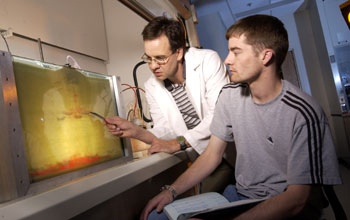Multimedia Gallery
Two-Dimensional Aquifer Cell
Two-Dimensional Aquifer Cell
Researchers Kurt Pennell (left) and Eric Suchomel examine a two-dimensional aquifer cell designed to simulate a spill of tricholoroethene (TCE), which is dyed red.
This image was taken as part of research in which environmental engineers from Georgia Institute of Technology developed a two-part approach to clean up toxic chlorinated solvents spilled into underground water supplies from former dry cleaning and industrial operations.
The technique, which uses a macro emulsion composed of alcohol and food-grade surfactants, simultaneously reduces the density of the pollutant to keep it from sinking farther into the groundwater and helps separate if from soil particles so that it can be flushed out. The approach is known as density modified displacement and is expected to cut costs in environmental remediation by reducing the time required for cleanup and the amount of contaminant effluent that must be treated. (Date of Image: 2003)
Credit: Photo by Gary Meek; courtesy Georgia Tech
Special Restrictions: For editorial use only; not for advertising, commercial or for-profit use.
Images and other media in the National Science Foundation Multimedia Gallery are available for use in print and electronic material by NSF employees, members of the media, university staff, teachers and the general public. All media in the gallery are intended for personal, educational and nonprofit/non-commercial use only.
Images credited to the National Science Foundation, a federal agency, are in the public domain. The images were created by employees of the United States Government as part of their official duties or prepared by contractors as "works for hire" for NSF. You may freely use NSF-credited images and, at your discretion, credit NSF with a "Courtesy: National Science Foundation" notation.
Additional information about general usage can be found in Conditions.
Also Available:
Download the high-resolution JPG version of the image. (2 MB)
Use your mouse to right-click (Mac users may need to Ctrl-click) the link above and choose the option that will save the file or target to your computer.



